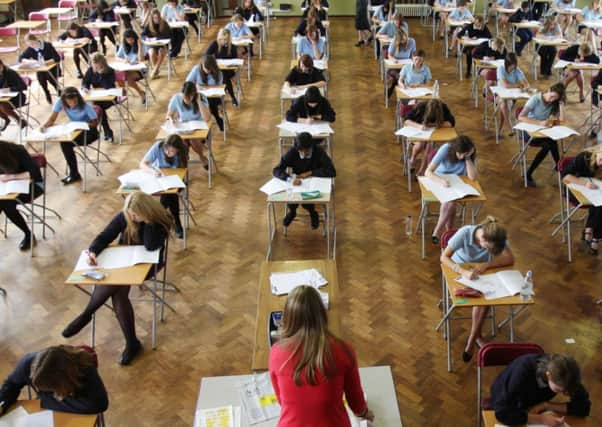Yorkshire at foot of GCSE league table


The level of 16-year-olds coming out with at least five Cs, including English and maths, dropped to 53 per cent, the lowest of any region in England.
Yorkshire’s results last year had taken the region off the foot of the table, ahead of the North East and East Midlands, but the county is again back at the bottom.
Advertisement
Hide AdAdvertisement
Hide AdCalderdale Council’s head of learning services, David Whalley, said: “The provisional data that we have indicates that 59 per cent of Calderdale’s GCSE students (based on the new first entry for GCSE policy) gained five A* to C grades, including English and maths. This is above the average percentage nationally and for Yorkshire and Humberside – Calderdale is in the top five in the region.
“Although nationally there has been a dip compared to last year’s results, Calderdale has seen a smaller decrease than many other local authorities.”
Within Yorkshire, the best results this year were in York where nearly 62 per cent of pupils achieved the benchmark of at least five good passes, followed by North Yorkshire with 60 per cent.
The weakest students are in Bradford where just 43.4 per cent reached the Government target, followed by Hull on 43.9, Barnsley on 45.7 and Doncaster on 48.5 per cent.
Advertisement
Hide AdAdvertisement
Hide AdNationally, fewer teenagers scored at least five C grades in their GCSEs, including English and maths, this year amid major changes to the exams and school league tables.
In total, just over half (52.6 per cent) of pupils in England gained five or more A* to C grades, including the basics, according to statistics published by the Department for Education (DfE).
This is down from 59.2 per cent who achieved the same standard last year, although Government officials said it was difficult to compare the latest results with previous years due to major reforms.
These include a move to cut thousands of vocational qualifications from school performance measures, and the decision that only a student’s first attempt at a GCSE will count in the league tables.
Advertisement
Hide AdAdvertisement
Hide AdBut the statistics also suggest that using last year’s methodology, around 56 per cent of pupils achieved at least five Cs, including English and maths, this year - still down on last year.
The DfE insisted that the falls across all types of schools comes amid exam reforms it says are designed to ensure the qualifications remain of a high standard.
It added that most of the 4.7 percentage point reduction in state school pupils’ results, is down to early entry and vocational qualification reforms.
Education Secretary Nicky Morgan said: “I am delighted to see more and more young people taking the high quality subjects that will properly prepare them for life in modern Britain.
Advertisement
Hide AdAdvertisement
Hide Ad“With record numbers taking science at GCSE and maths now the most popular subject at A-level our plan for education has finally reversed the decline in key academic subjects.”
Paul Brennan, deputy director of children’s services at Leeds Council, was critical of the exam system changes.
“It is unfortunate that the new exam system introduced by Ofqual this year was not as flexible as in previous years and favours more academic pupils. Less coursework was able to count towards the end result, and there were more end-of-course exams rather than exams being taken throughout the year. Changes to the range and number of non-GCSE qualifications which are counted in the performance tables have also affected results. It is very disappointing that these changes have clearly disadvantaged children in Leeds this year.
“It also means that pupils whose potential is better reached through vocational and modular learning, and who have worked incredibly hard, might not see their efforts reflected in their results as positively as they should be.”
He said many achieved higher grades than those reported as only first attempts were counted.